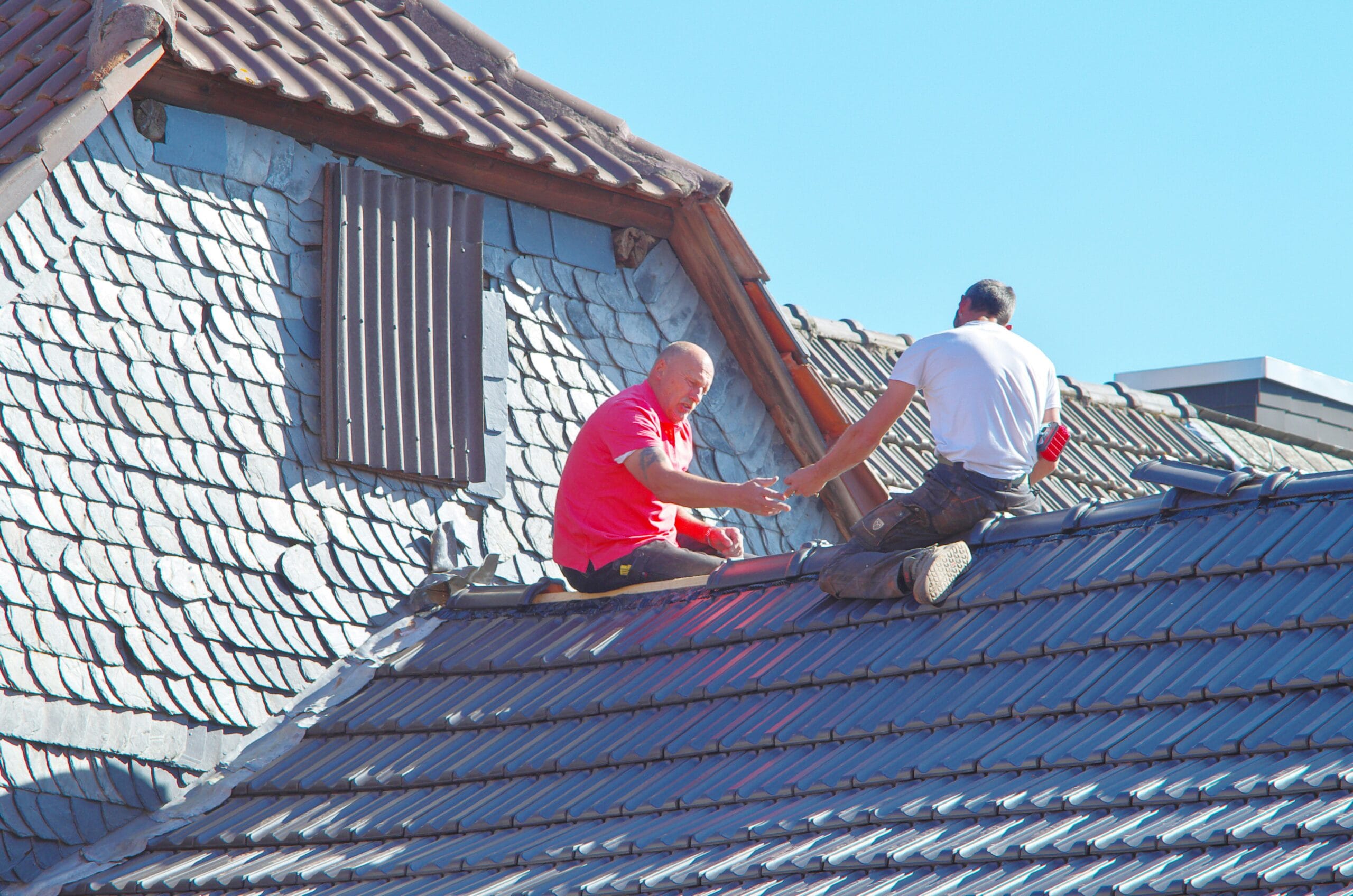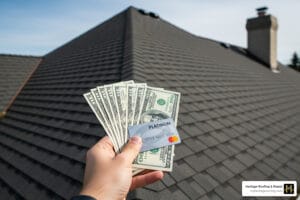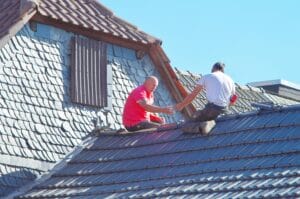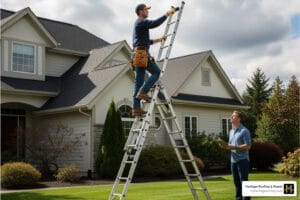Why Proper Shingle Replacement is Critical for Your Home
Your roof is your home’s first line of defense, and even a few damaged shingles can compromise its integrity, leading to costly water damage and structural issues. Whether you’re dealing with the aftermath of a storm or the natural wear and tear of aging, understanding how to handle shingle roof repair is essential for every homeowner. For over 50 years, our family at Heritage Roofing & Repair has been dedicated to providing top-quality roofing services, and we know that timely, correct repairs can save you thousands in the long run.
Quick Guide to Shingle Roof Repair:
- Minor repairs (1-2 shingles): Often a manageable DIY project with the right tools and safety precautions.
- Moderate damage (multiple shingles): Consider calling a professional to ensure a lasting fix.
- Extensive damage (25%+ of roof): Call a professional immediately to prevent further issues.
- Average repair cost: $350-$1,500, a fraction of the $5,700-$12,000 for a full replacement.
- Best conditions: Warm, dry weather when shingles are pliable and less prone to cracking.
While small fixes like replacing a single shingle can be a DIY task, extensive damage, steep roofs, or issues near flashing require professional expertise to ensure your home remains protected. I’m Rex Wisdom, owner of Heritage Roofing & Repair, and I’ve spent my life helping Northwest Arkansas homeowners with their roofing needs. We’ve seen it all, from minor storm damage to the effects of long-term wear, and we know when a quick fix is enough and when you need an expert.
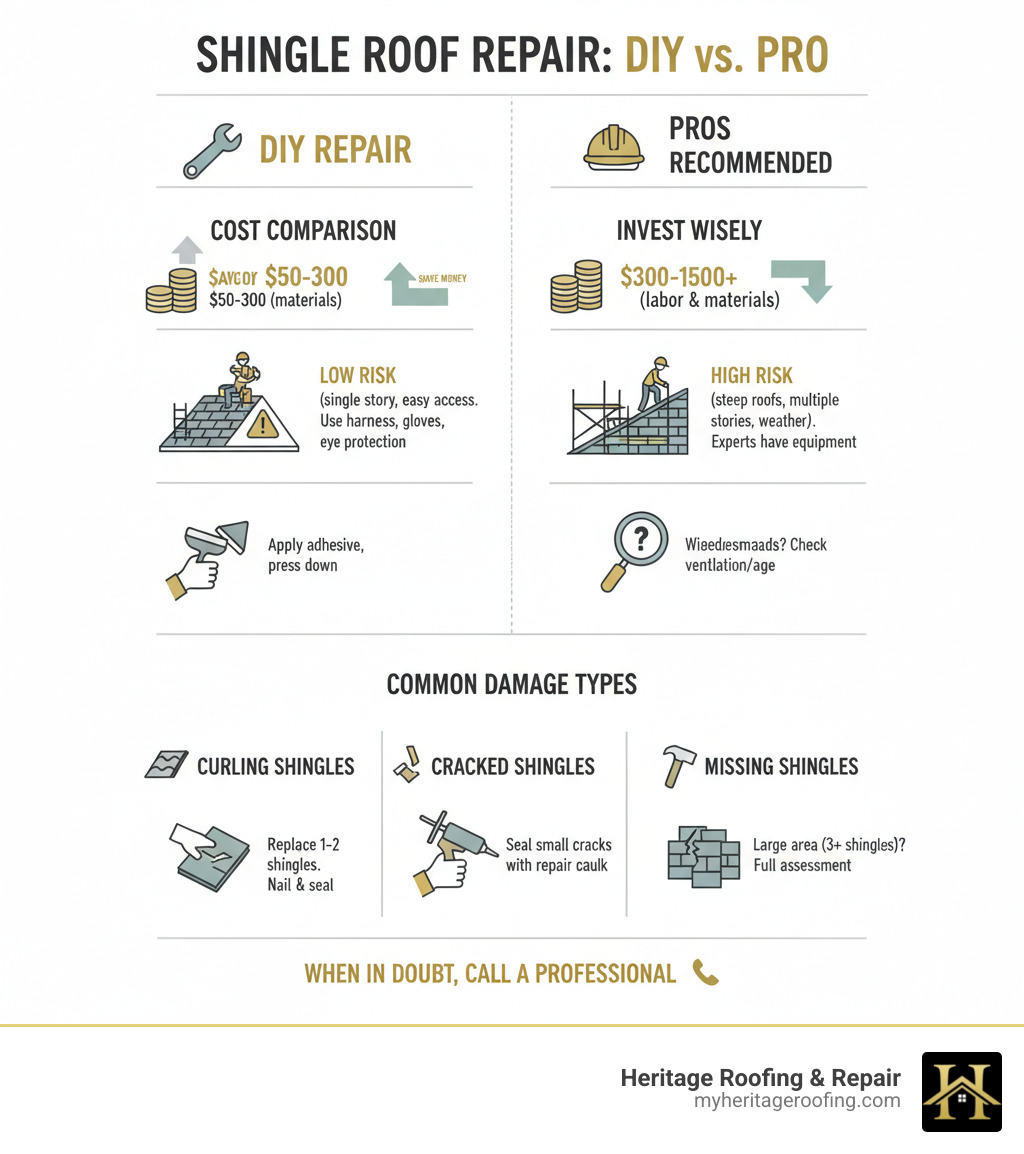
Basic Shingle Roof Repair Glossary:
- Emergency Roof Repair: Immediate action taken to prevent further damage after a severe event, like a storm.
- Roof Insurance Claim: The process of filing a claim with your insurance company to cover the cost of roof damage.
Identifying Common Shingle Damage
Before you can tackle any shingle roof repair, you need to know what to look for. The good news is that most common shingle problems are visible from the ground, especially with a pair of binoculars. Regularly inspecting your roof is like a health check-up for your home, helping you catch issues before they escalate into major, costly repairs.
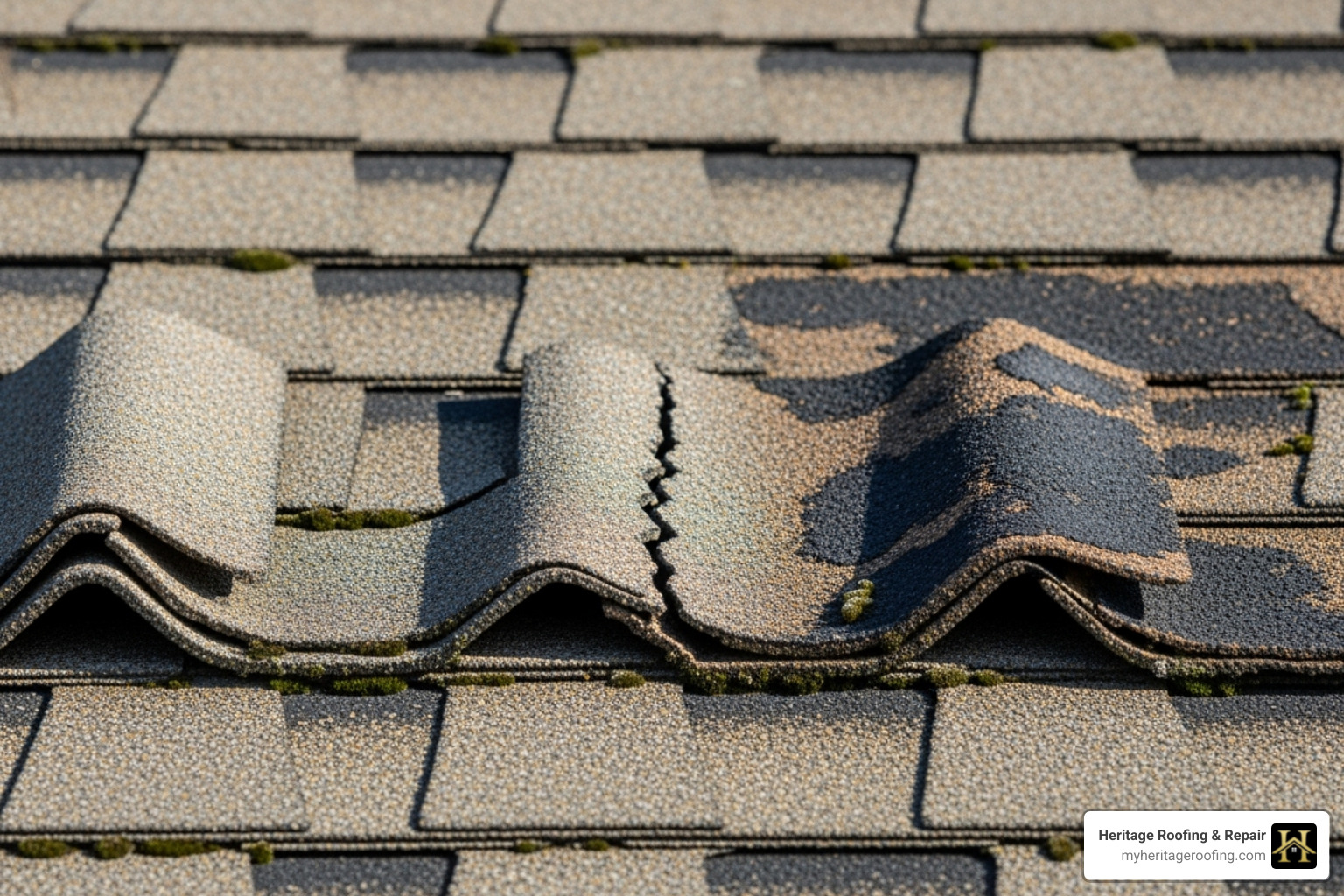
- Curling Shingles: Shingles that curl at the edges or cup in the middle are often a sign of age or moisture issues. This compromises their ability to shed water effectively.
- Cracking or Splitting: Caused by sun exposure and temperature changes, these cracks create direct paths for water to enter your home.
- Missing Granules: You might notice these as dark or “bald” spots on your roof, with granules collecting in your gutters. These granules protect the shingle from UV damage, and their loss is a sign of wear.
- Missing or Loose Shingles: Often the result of high winds, these are obvious weak points in your roof’s defense system.
- Blistering: Small bubbles on the shingle’s surface, usually from trapped moisture or poor ventilation. When they pop, they expose the shingle’s core.
- Algae or Moss Growth: This organic growth traps moisture against the shingles, which can lift them and accelerate deterioration.
Signs Your Roof Needs Attention
Your home will often give you clues that your roof needs help. Pay attention to these warning signs to prevent small problems from becoming big ones.
- Water Stains on Your Ceiling: Yellow or brown marks are a clear sign that water has already penetrated your roof and is damaging your home’s interior.
- Leaks in the Attic: After a rainstorm, check your attic with a flashlight. Any dampness, drips, or wet insulation means your roof has been compromised.
- Granules in Gutters: While a few granules are normal, a large accumulation indicates that your shingles are aging and losing their protective layer.
- A Sagging Roof Deck: This is a serious structural issue, often caused by prolonged water damage weakening the underlying wood. If you see any dips in your roofline, call a professional immediately.
- Daylight Through Roof Boards: If you can see light from your attic, it’s a clear breach that needs immediate attention to prevent water, pests, and drafts from entering.
A Step-by-Step Guide to DIY Shingle Replacement
For minor, isolated damage on a roof that isn’t too steep, a DIY shingle roof repair is often manageable and can save you hundreds of dollars. However, I can’t stress this enough – always prioritize safety by using a sturdy ladder and working on a dry, calm day. Trust me, after five decades in this business, I’ve seen too many accidents happen when homeowners rush repairs in poor conditions.
Here’s something most people don’t realize: asphalt shingles are more pliable in warm weather, making them much easier to work with. If you’re attempting repairs on a chilly day, those shingles will be brittle and prone to cracking. We recommend tackling these tasks only if you’re comfortable with heights and have the right safety gear – there’s no shame in calling professionals if you have any doubts.
Essential Tools and Materials
Gathering your supplies beforehand makes the job go smoothly and keeps you safer. You can find most of these items at your local hardware store, and having everything ready before you climb onto the roof minimizes those dangerous trips up and down the ladder.
You’ll need a hammer for driving nails and a flat pry bar (also called a shingle ripper) for removing old nails and lifting shingles. A sharp utility knife with extra blades is essential for cutting shingles to size, while a caulking gun will help you apply sealant precisely.
Make sure your ladder is stable and securely placed – this isn’t the time to use that wobbly old stepladder from the garage. Safety glasses protect against flying debris, and good work gloves provide grip and protection from sharp edges.
For materials, you’ll need replacement shingles that match your existing ones as closely as possible in both color and style. 1¼-inch galvanized roofing nails resist corrosion, and asphalt-based roofing sealant or cement provides crucial waterproofing.
How to Replace a Damaged or Missing Shingle
Replacing a single shingle is straightforward, but the key is working carefully to avoid damaging surrounding shingles, especially on older roofs where they can become surprisingly brittle.
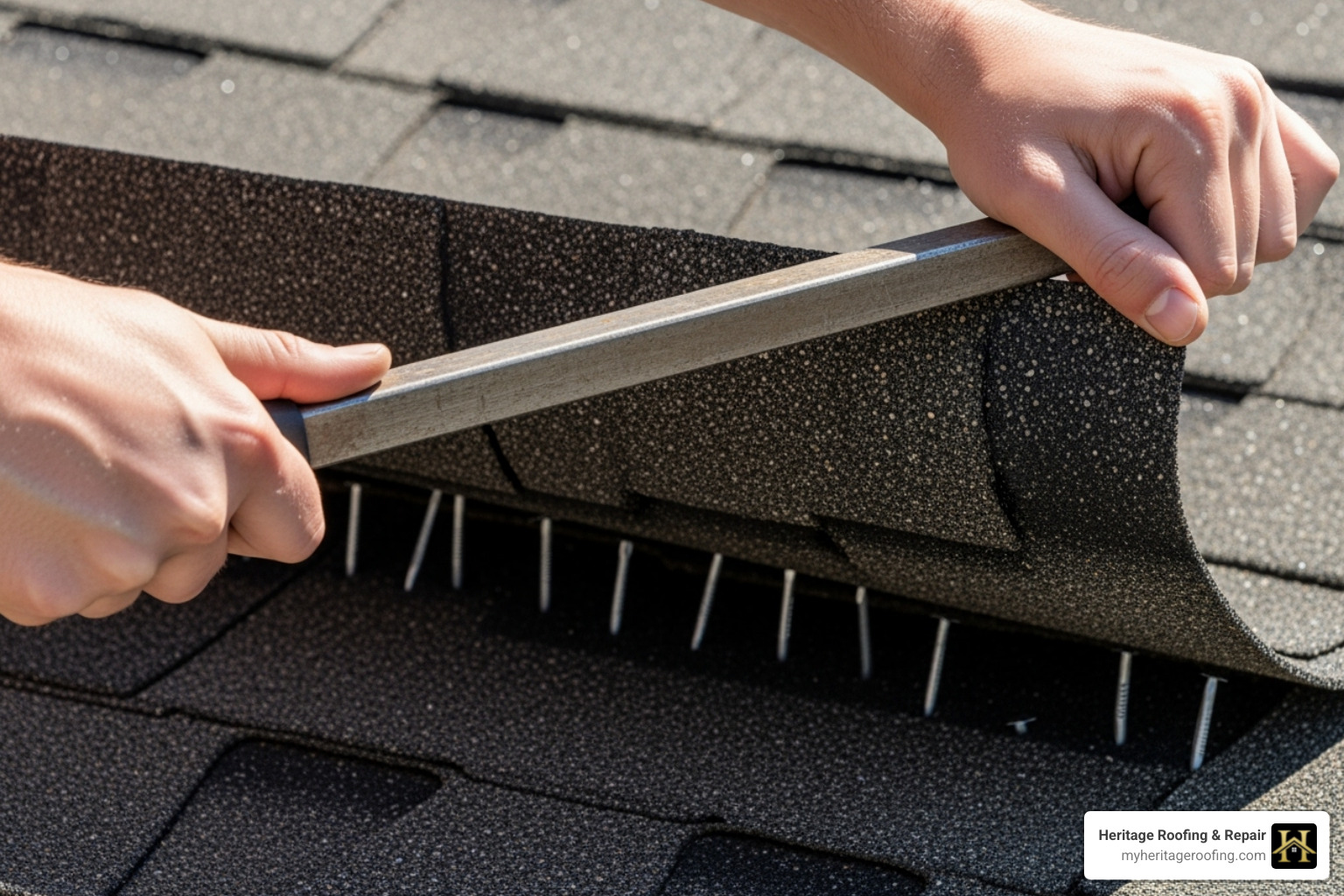
- Lift Surrounding Shingles: Gently use a pry bar to lift the shingles above and to the sides of the damaged one. Be patient to avoid causing new cracks.
- Remove Old Nails: Slide the pry bar under the damaged shingle to locate and remove the nails holding it in place.
- Remove and Inspect: Slide the old shingle out. Check the underlayment for any tears or damage and patch with roofing cement if needed.
- Install New Shingle: Slide the new shingle into place, aligning it with the surrounding ones. Secure it with four 1¼-inch roofing nails, one at each corner, about an inch above the cutouts. Drive nails flush, but not so deep that they puncture the shingle.
- Seal the Edges: Apply a small dab of roofing sealant under the tabs of the new shingle and the ones you lifted. Press them down firmly to create a watertight seal.
How to Fix Curled or Cracked Shingles
For minor curls or cracks, you can often make a quick repair without replacing the whole shingle.
- Apply Sealant: Carefully lift the curled edge or apply sealant directly under the crack.
- Press and Secure: Press the shingle down firmly. For curled shingles, you can place a brick on top for 24 hours to help it bond.
- Seal the Top (for cracks): For cracked shingles, apply a thin layer of sealant over the top of the crack and smooth it with a putty knife. You can sprinkle loose granules from your gutter over the wet sealant to help it blend in.
Professional Shingle Roof Repair vs. DIY: Making the Right Call
Knowing your limits is crucial for any home improvement project, especially roofing. While DIY can save money on small fixes, improper repairs can lead to bigger, more expensive problems. According to the National Roofing Contractors Association (NRCA), hiring a qualified professional ensures the job is done right.
We’ve seen countless cases where well-intentioned DIY efforts resulted in more extensive damage. A homeowner might try to fix a simple leak, only to puncture the underlayment or damage surrounding shingles in the process. What started as a $200 repair suddenly becomes a $2,000 problem. We’d much rather you call us before it gets to that point!
The key is being brutally honest about your skills, comfort level, and the complexity of the damage you’re facing. Shingle roof repair isn’t just about hammering in a few nails—it requires understanding how water flows, how shingles overlap, and how to maintain the integrity of your roof system.
When a DIY Fix Is Appropriate
A DIY approach works best when you’re a confident homeowner dealing with minimal damage on an easily accessible roof. Think of it this way: if you’re comfortable on a ladder, handy with basic tools, and the problem is truly isolated, you might be able to handle it yourself.
The sweet spot for DIY repairs is one or two missing shingles on a roof that’s relatively young and in good overall condition. Minor curling or cracking can also be addressed with some roofing sealant and patience. Your roof should be less than 15-20 years old with no signs of active leaks—these are non-negotiables for attempting repairs yourself.
Most importantly, stick to low-pitched roofs where you can maintain good footing and balance. If your roof is steep enough that you feel nervous walking on it, that’s your cue to call a professional. No repair is worth a trip to the emergency room.
Signs You Need a Professional for Shingle Roof Repair
Some situations are clear red flags that scream “call the experts.” Extensive damage affecting more than 25% of your roof means you’re looking at systemic issues, not isolated problems. This level of damage suggests severe weather impact or underlying roof failure that patchwork repairs won’t solve.
Multiple leaks or water stains on ceilings tell a different story than a single drip. While one leak might point to a specific shingle issue, widespread water intrusion indicates problems with your roof system, potentially involving underlayment or flashing failures.
Age matters tremendously in roofing decisions. If your roof is over 20 years old, even minor damage can signal that the entire system is deteriorating. Continuing to patch an aging roof often becomes a money pit—you’ll spend more on repairs than replacement would cost.
Roof deck sagging is an immediate safety concern requiring professional assessment. This indicates water damage or compromised structural integrity, far beyond simple shingle replacement. Similarly, any damage near flashing, valleys, or chimneys requires expert attention. These critical areas where different roof components meet are notorious leak sources when repaired incorrectly.
Finally, steeply pitched roofs are simply too dangerous for most homeowners. Professional roofers have the training, equipment, and insurance to work safely at heights. Your family needs you in one piece more than they need to save a few hundred dollars.
If you see any of these warning signs, it’s time to contact a professional for an expert roof repair. For homeowners in and around Berryville, AR, Heritage Roofing & Repair provides safe, effective solutions backed by over 50 years of trusted experience.
Heritage Roofing & Repair
3458 Arkansas State Hwy 221, Berryville, AR 72616
(870) 654-1164
We specialize in storm damage repair and insurance claims, providing dependable, affordable, and quality craftsmanship for local homeowners and businesses. When the job requires professional expertise, we’re here to ensure it’s done right the first time.
Costs, Benefits, and Prevention
Understanding the financial side of roof maintenance helps you budget and make smart decisions. Timely repairs are always more cost-effective than a full replacement forced by neglect. We often tell our clients that an ounce of prevention is worth a pound of cure, and nowhere is that truer than with your roof!
The Cost of Shingle Roof Repair vs. Full Replacement
The difference in cost is significant. While a minor repair is affordable, a full replacement is a major investment. Knowing these numbers helps you weigh your options.
| Service | Average Cost Range | Notes |
|---|---|---|
| Average Repair Cost | $350 – $1,500 | Covers minor to moderate repairs, like replacing a few shingles or fixing a small leak. |
| Replacing Missing Shingles | $100 – $600 | For a small section of shingles, often after storm damage. |
| Fixing Curled or Lightly Damaged Shingles | $10 – $50 (DIY) | An inexpensive DIY fix using roofing cement. |
| Asphalt Roof Leak Repair | $350 – $1,000 | Cost depends on the leak’s size and complexity. |
| Asphalt Shingle Roof Flashing Repair | $200 – $500 | Flashing around chimneys, vents, or valleys is crucial and requires specialized attention. |
| Asphalt Shingle Roof Cleaning / Moss Removal | $250 – $1,500 | Regular cleaning every 1-3 years helps extend roof life. |
| Roof Inspection | $100 – $400 | A professional inspection helps identify issues before they become major problems. |
Preventative Maintenance to Extend Your Roof’s Life
Proactive care is the best way to maximize the lifespan of your roof, which for asphalt shingles is typically 15 to 30 years. Simple, regular tasks can save you thousands in the long run. For more ideas, explore our roofing tips & advice.
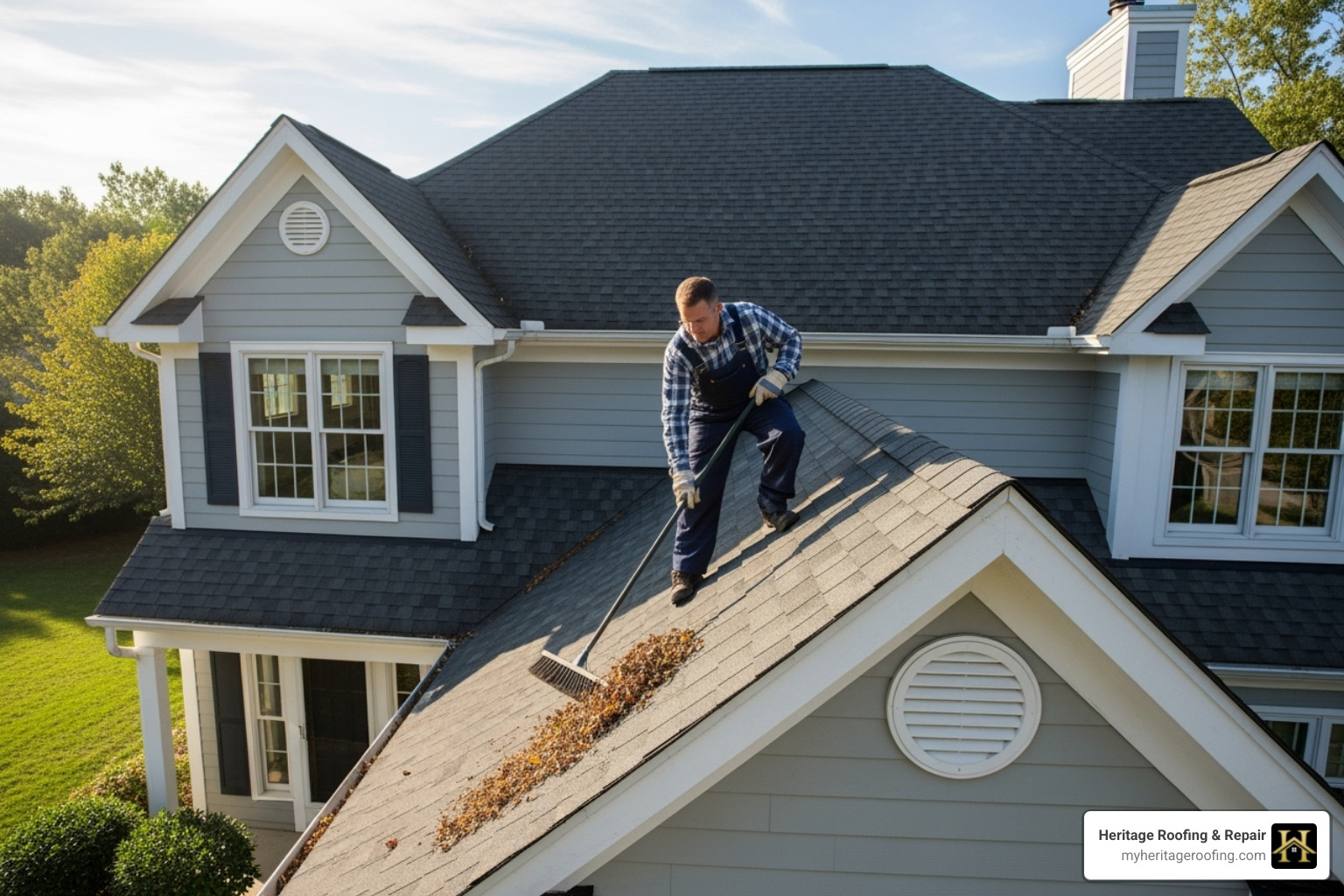
- Regular inspections (twice a year): We recommend performing visual inspections of your roof at least twice a year, ideally in the spring and fall. After any major storm, it’s also wise to do a quick check. Look for any of the damage signs we discussed earlier: curling, cracking, missing granules, or loose shingles. Early detection is key!
- Clean gutters and downspouts: Clogged gutters can cause water to back up and seep under your shingles, leading to water damage and rot in your fascia and soffit. Keep them clear of leaves, twigs, and other debris. Ensure downspouts direct water away from your home’s foundation.
- Trim overhanging branches: Tree branches rubbing against your roof can abrade shingles, causing granule loss and premature wear. In a storm, heavy branches can break and fall, causing significant damage. Trimming them back protects your roof from both constant friction and sudden impact.
- Remove debris: Leaves, pine needles, and other organic debris can accumulate on your roof, especially in valleys and around chimneys. This debris traps moisture, encourages moss and algae growth, and can accelerate shingle deterioration. Regularly sweep or blow off your roof to keep it clean.
- Manage snow and ice to prevent ice dams: In colder climates like parts of Northwest Arkansas, heavy snow and ice can lead to ice dams. These occur when melted snow refreezes at the eaves, causing water to back up under your shingles. Proper attic ventilation and insulation are crucial here, but safely removing excessive snow can also help.
Frequently Asked Questions about Shingle Repair
We get a lot of questions from homeowners about their shingle roofs. Here are some of the most common ones we encounter, along with our expert answers.
How long do asphalt shingles last?
Asphalt shingles typically last 15 to 30 years on average. However, this lifespan isn’t set in stone; it’s influenced by several factors:
- Quality of the shingle: Higher quality, architectural, or luxury shingles generally have a longer lifespan than basic 3-tab shingles.
- Climate: Harsh weather conditions, including intense UV exposure, extreme temperature fluctuations, heavy rain, strong winds, and hail, can significantly reduce a shingle’s life. Roofs in areas with warmer climates or frequent storms often require replacement sooner.
- Quality of installation: Proper installation, including correct nailing patterns and adequate underlayment, is critical. A poorly installed roof, even with high-quality materials, will fail prematurely.
- Ventilation: Good attic ventilation helps regulate roof deck temperature, preventing premature aging of shingles from excessive heat. It also mitigates moisture buildup.
- Maintenance: Regular cleaning and timely repairs, as we’ve discussed, can help your shingles reach the upper end of their expected lifespan.
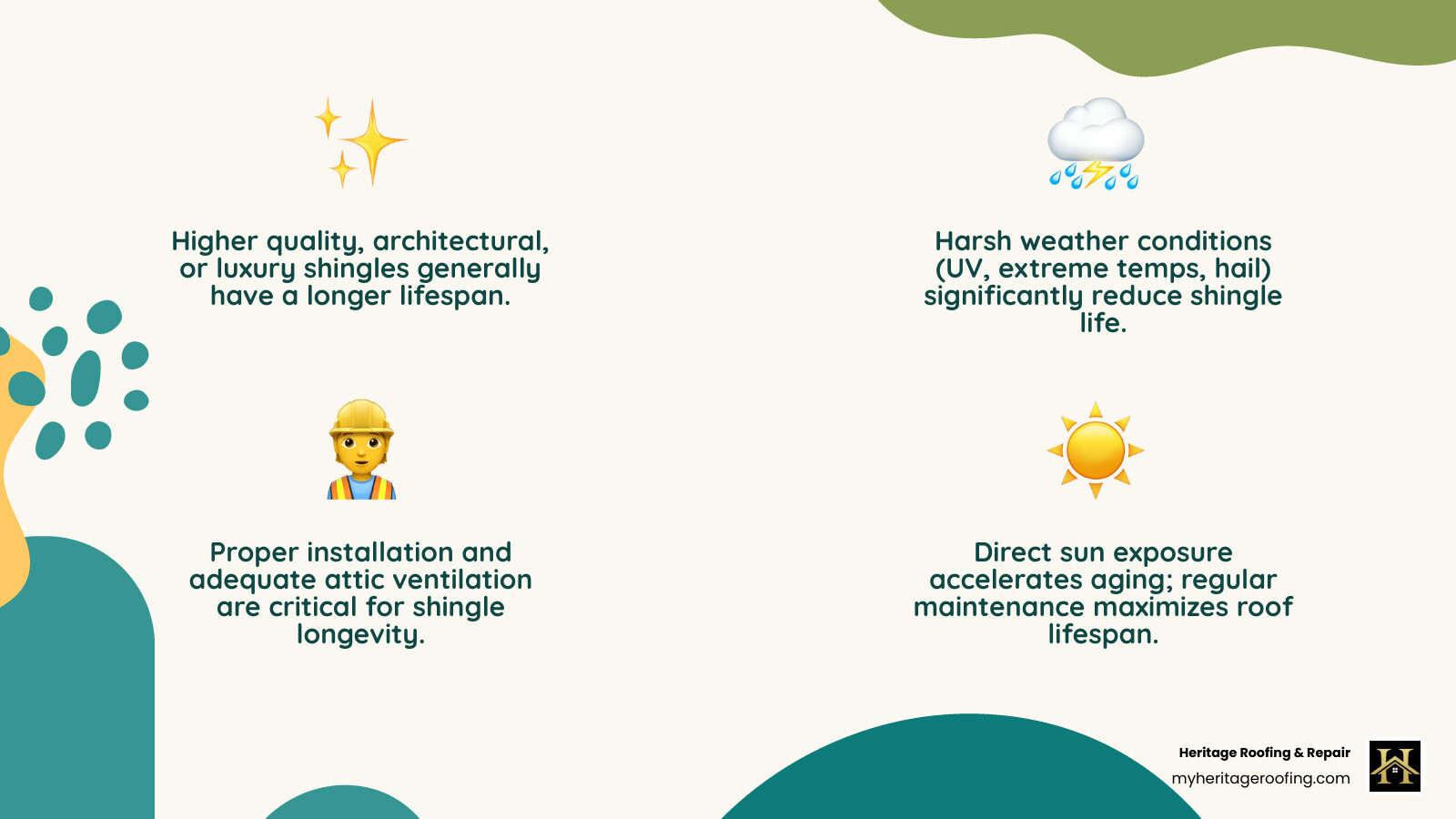
Is it worth repairing an asphalt shingle roof?
Yes, it is often worth repairing an asphalt shingle roof, but it depends on the overall condition and age of your roof. We generally recommend repair if:
- The roof is less than 20 years old: For roofs still in their prime, isolated damage is usually repairable, and patching a few shingles can extend the life of the entire system.
- The damage is confined to a small area: If only a small section (e.g., less than 25% of the total roof area) is affected, repairing those specific spots is far more cost-effective than a full replacement.
- The majority of the shingles are in good condition: If most of your shingles are still pliable, have good granule coverage, and are not curling or cracking extensively, then repairing the damaged ones makes sense.
However, if your roof is older, has widespread damage, or is experiencing multiple leaks, a full replacement may be the more economical and practical long-term solution.
Can I repair a roof with two layers of shingles?
Yes, you can repair a roof with two layers of shingles, but it’s often more complex and potentially more costly than repairing a single-layer roof.
The primary challenge is that to properly repair the damaged section and ensure a watertight seal, contractors often must remove both layers of shingles in that area. Simply patching over the top layer might not effectively address issues in the underlayment or the first shingle layer, leading to recurring leaks. Removing both layers increases labor and disposal costs.
Furthermore, many building codes, including the International Residential Code (IRC), typically limit roofs to a maximum of two shingle layers. If your roof already has two layers and is experiencing significant damage, we would generally advise considering a full tear-off and replacement. This ensures your roof meets current building codes, allows for a thorough inspection of the roof deck, and provides a new, long-lasting roofing system.
Your Partner for a Secure Roof in Northwest Arkansas
Taking care of your shingle roof repair needs doesn’t have to be overwhelming. When you understand the basics of identifying damage, know which repairs you can safely handle yourself, and recognize when it’s time to call in the professionals, you’re already ahead of the game. Regular inspections and prompt attention to small problems will save you from those heart-stopping moments when water starts dripping through your ceiling during a storm.
The truth is, most homeowners can handle minor shingle repairs like fixing a few curled edges or replacing one or two missing shingles. But there’s real wisdom in knowing your limits. When you’re dealing with extensive damage, multiple leaks, or anything involving your roof’s flashing or structural components, that’s when you want experienced hands on the job.
At Heritage Roofing & Repair, we’ve been helping Northwest Arkansas families protect their homes for over 50 years. We’ve seen what happens when small problems get ignored, and we’ve also seen how proper maintenance can help a roof reach its full potential lifespan. Whether you need a quick repair or a complete roof assessment, we bring the same careful attention to every job.
Our team specializes in storm damage repair and insurance claims, so we understand the urgency when weather hits hard. We know how to work with insurance companies to make sure you get the coverage you deserve, and we’re committed to providing dependable, affordable solutions that stand the test of time.
If you’re in the Harrison area and want peace of mind about your roof’s condition, our team of expert roofers in Harrison, AR is ready to provide a thorough, honest assessment. We’ll tell you exactly what needs attention and what can wait, helping you make informed decisions about your home’s protection. Contact us for a free estimate and let us help you keep your family safe and dry for years to come.
